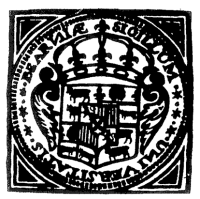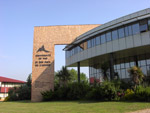History of the University
In 1809, France was divided into academic regions as part of the creation of the Napoleonic University system, and Pau became the seat of an academic region, covering the Basses Pyrénées (today's Pyrénées Atlantiques), Hautes Pyrénees and Landes areas (or départements). In 1848, the Second Republic put an end to this division
The UPPA is created in several steps from 1946 to 1970.
On 29 July 1946, the Lycée Louis Barthou hosted summer courses organised by the Faculty of Arts and Humanities of the University of Bordeaux, later known as the Institut d'Etudes Françaises d'Eté (the Summer Institute of French Studies). For the first time, inhabitants of Pau shared their city with university students. The courses were taught by teachers from Bordeaux.
On 12 October 1946, the Chief Education Officer (recteur) in Bordeaux, André Marchaud, signed an agreement with the Dean of Bordeaux's Faculty of Law, Henri Vivioz, which authorised the teaching of Law courses in Pau. Robert Poplawski became head of this newly created Institut d'Etudes Juridiques et Economiques (Institute for Legal Studies and Economics), a branch of the University of Bordeaux in Béarn, based in the Lawrence Villa in Pau.
Courses continued to be taught by teachers from Bordeaux, but local magistrates and lawyers gradually began to participate.
In 1955, a Chair of Legal History was created in the Institute. For the first time, a University Professor would hold a position in Pau.
On 26 February 1958, an Institut des Lettres et Sciences Humaines (Institute for Arts and Humanities) was created in Pau, located in the Formose Villa.
On 11 March of the same year, the municipality purchased a property in the Tourasse area, on which to build the future campus (today's campus).
In November 1959, a Sciences College, which depended on the University of Bordeaux, welcomed its first students on our current campus, in the former premises of the plant nursery (moved to Sers) remodelled for the purpose.
On 31 July 1961, the Institute for Arts and Humanities, under the leadership of the Dean Louis Papy, became a College, the Collège Littéraire Universitaire (University College of Arts and Humanities), a status implying a financial contribution from the French State.
In September 1964, Law students attended their classes in temporary premises set up on the Pau campus.
In 1965, the Faculty of Sciences building was constructed (architect: Pierre MATHIEU).
On 1 October 1968, the College of Arts and the College of Sciences both became Faculties. In December 1968, the Institute for Legal Studies and Economics also became a Faculty.
The legal status of these three Faculties therefore implies that a full-status University had now been created.
The Law on Higher Education Reform voted on 12 November 1968 intended to replace Faculties by Teaching and Research Units (Unités d'Enseignement et de Recherche, UER), grouped into Universities. The University of Pau took part in this process.
On 17 December 1970, a presidential decree formalised the creation of the Université de Pau et des Pays de l'Adour (UPPA), comprising the three existing Teaching and Research Units, in Law and Economics, in Arts and Humanities and in Exact and Natural Sciences, as well as a new one : a University Institute for Scientific Research (Institut Universitaire de Recherche Scientifique, IURS). This new UER was meant to consolidate the management of all research activities carried out at this new University of Pau. However, in reality, research groups in Law and Economics remained dependent on their own UER.
In 1970, an Institute for Legal Studies and Economics (Institut d'Etudes Juridiques et Economiques, IEJE) was created in Bayonne, following the suggestion of the Bayonne-Anglet-Biarritz District (BAB) and a decision taken by the University Board.
Evolution to the Present Day
President of the University from 1970 to 1973: Maurice Descotes
1971: Construction of the Arts and Humanities UER building (architect: André Grézy). Extensions to this building were added in 1995 and 2001.
President from 1973 to 1976: Jean Deschamps
1977 : Construction of the Law and Economics UER building (architect: André Grézy). Extensions to this building were added in 1991 and 1996.
1975 :IUT des Pays de l'AdourGEA
President from 1976 to 1982: Daniel Levier
President from 1982 to 1988: Franck Metras
1984: creation of an IT Department within the Institute of Technology in Bayonne.
1985: creation of a fifth UFR (Unité de Formation et de Recherche, a Training and Research Unit), a multidisciplinary Faculty located in Bayonne.
The other UERs also became UFRs as part of the implementation of the Act of 26 April 1984 on Higher Education (known as the Savary Law).
The IURS became the CURS, a University Centre for Scientific Research.
Creation of the IBEAS, an Institute for the experimental study of biocenosis in agrosystems.
Creation of the first Department of the Institute of Technology to be located in Pau: the Department of Thermal Engineering and Energy (GTE).
President from 1988 to 1993: Jean-Louis Gout
1987: creation of the IPRA, a Multidisciplinary Institute for Applied Research (architect: Camborde-Lamaison).
1989: creation of the IRSAM, a Research Institute on Societies and Territorial Planning in Mountainous Regions (architect: André Grésy).
1990: creation of the IFR, an Institute for Training and Research (Institut de Formation et de Recherche).
1991: creation of the ENS GTI, a School of Industrial Technology Engineering (Ferry building, architect: ACTA - Lavoisier building of the Technology Centre, architect: Camborde-Lamaison).
The Institute for Business Management (IAE) of the University of Pau, created in 1963, acquired the status of independent Institute within the UPPA in 1991, in accordance with the application of Article 33 of the Act of 26 January 1984 (Article L719-9 of the French Education Code).
Construction of an extension to the Faculty of Law and Economics building in 1991 and 1996 (architect: Grezy Architectes).
1992: creation of a second Department within the Institute of Technology in Pau: the Department of Statistics and Computer Data Processing (STID) (architect: Camborde-Lamaison).
President from 1993 to 1998: Claude Laugénie
1993 : construction of the Applied Biology building within the Pays de l'Adour Institute of Technology in Mont-de-Marsan and, in 1997, of the building for the new Telecommmunications and Network Engineering Department (GTR) - Architects : LEJEUNES & Associés.
December 1993: the Institute of Technology split and, as a result, the Bayonne Institute of Technology (IUT de Bayonne) was created.
1994: construction of the Presidency building (architect: André Grézy).
From this moment on, the administrative offices of the Pays de l'Adour Institute of Technology are based in Pau.
1996: creation of the Department of Sport Science (STAPS) in Tarbes, in response to a growing demand for this type of course of study, and with a view to reducing the excess of students in the neighbouring Universities of Bordeaux and Toulouse.
The campus in Tarbes (which is part of the Pays de l'Adour area) was chosen as the location for this new Department on political grounds.
1997: construction of the GTR building in Mont-de-Marsan (architects: LEJEUNES & Associés).
President from 1998 to 2004: Jean-Louis Gout
1999 : creation of a branch of the Faculty of Sciences and Technology (UFR Sciences et Techniques) of Pau on the Basque Coast.
The creation of the UPPA campus in Anglet took place in the 1990s, with the support of local communities. The site chosen for the project was an old property purchased by the town of Anglet and put at the disposal of the BAB federation of municipalities (Bayonne, Anglet, Biarritz).
The first building, jointly funded by the French State and the Aquitaine region (on the basis of a State-region project contract), was built at the end of the 1990s and was opened to the public in 1999 (architect: Pierre Caillot).
2001: construction of the first building for the Department of Sport Science (STAPS) in Tarbes (architect: Atelier d'architecture Gil et Peretto).
2002: the branch of the Faculty of Sciences and Technology based on the Basque Coast became an independent Training and Research Unit.
Creation of the Department of Materials Science and Engineering (SGM) in Mont-de-Marsan (within the Institute of Technology).
2003: construction of the Maison de l'Etudiant (MDE), the University's Cultural Services building - Architect: Cachau).
2004: construction of the Sports Hall in Tarbes (architect: RVL Architecture).
President from 2004 to 2008 : Jean-Michel Uhaldeborde
2007 : construction of an extension to the Faculty of Sciences and Technology building in Anglet.
The scientific Departments of the Bayonne Institute of Technology, the Computer Science Departments (previously located in the Chateau Neuf), the professional Bachelor's degree in Computer Systems and Software and the new Department of Industrial Engineering and Maintenance (GIM) created in September 2007 were all moved into a new building on the Montaury campus in Anglet (architect: SEQUENCES). Construction of the Sports Hall in Pau (architect: Camborde-Lamaison).
Construction of premises in Hélioparc for the Multidisciplinary Research Institute for Environmental Science and Materials (IPREM) - Architect: Camborde-Lamaison).
President from 2008 to 2012: Jean-Louis Gout
2008 : the IPREM moved into its new premises in Hélioparc.
Beginning of the construction of the Department of Materials Science and Engineering building at the Institute of Technology of Mont-de-Marsan.
September 2008: the Bayonne-Anglet-Biarritz Multidisciplinary Faculty, the Institute for Business Management (IAE), the Bayonne Institute of Technology (Department of Business and Administration Management - GEA, Department of Marketing - Tech de Co), the European Resource and Research Centre (CDRE), the Research Centre on the Basque language and on Basque texts (IKER Joint Research Unit) as well as the Multimedia Language Centre (CLEREMO) all moved into their new premises on the Nive Campus (architecte: Antoine STINCO).
This former military site harmoniously combines old barracks, buttresses, bastions and new buildings.
September 2010: inauguration of new premises dedicated to research activities and also of additional classrooms in Tarbes.
January 2012: inauguration of two Technology Centres in Mont-de-Marsan, dedicated to the Department of Biological Engineering and the Department of Materials Science and Engineering.
President from 2012 to 2020: Mohamed Amara
2012: EQUIPEX (Investissement d'Avenir) accreditation for the MARSS project led by IPREM
2012: IDEFI (Investissement d'Avenir) accreditation of the PYREN project, with Spanish cross-border public universities.
2015: inauguration of the extension of the research premises of the UFR Law and Economics Management and the IAE
2015: inauguration of the Aquitaine Technology Centre for Advanced Materials and Composites CANOE
February 2017: I-SITE (Investissement d'avenir) accreditation of the E2S UPPA project led by the UPPA, INRA, Inria consortium
November 2017: inauguration of the central security post and the LaTEP/ Equipex MARSS technology hall
January 2018: reorganisation of UPPA into 3 colleges,
- College EEI, European and International Studies, including the multidisciplinary UFR of Bayonne and the IAE.
- SSH College, Social Sciences and Humanities, resulting from the merger of the Humanities, Languages, Humanities and Sport UFR (LLSHS) with the Law, Economics and Management UFR (DEG)
- STEE College, Sciences and technologies for energy and the environment, grouping together the Science and Technology UFRs of Pau and Anglet, the ENSGTI, the ISABTP as well as the two IUTs of the Adour and Bayonne regions.
July 2020: labelling as a European University of the UNITA "Universitas Montium" project, an alliance with the Università degli studi di Torino (Italy, coordinator), the Université Savoie-Mont-Blanc, the Universidad de Zaragoza (Spain), the Universidade da Beira Interior (Portugal), and the Universitatea de Vest din Timişoara (Romania).



